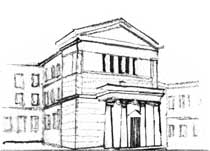Condensed Matter Physics Seminar
2006/2007 | 2007/2008 | 2008/2009 | 2009/2010 | 2010/2011 | 2011/2012 | 2012/2013 | 2013/2014 | 2014/2015 | 2015/2016 | 2016/2017 | 2017/2018 | 2018/2019 | 2019/2020 | 2020/2021 | 2021/2022 | 2022/2023 | 2023/2024 | 2024/2025
2013-12-20 (Friday)
Michał Matuszewski (IF PAN)
Kondensacja w laserach polarytonowo-ekscytonowych a uniwersalność
Przejściom fazowym drugiego rodzaju zachodzącym w skończonym czasiemoże towarzyszyć powstawanie rożnorodnych defektów, takich jak wiry,struny, monopole czy solitony. Teoria tego zjawiska opracowana przezToma W. B. Kibble'a i Wojciecha H. Żurka na przełomie latsiedemdziesiątych i osiemdziesiątych znalazła zastosowanie w licznychmodelach, m.in. od opisu wczesnej ewolucji wszechświata i formowaniasię galaktyk, poprzez terię nadprzewodnictwa, po dynamikę ciekłychkryształów. W wystąpieniu przedstawię kondensację polarytonów jakoprzejście od stanu silnie nierównowagowego do układukwazi-równowagowego, w którym defekty mogą powstać na skali czasurzędu pikosekund.
2013-12-06 (Friday)
prof. Michał Kurzyński (Wydział Fizyki, Uniwersytet im. A. Mickiewicza, Poznań)
Protein dynamics and the theory of biological molecular machines
All biological molecular machines can be formally considered as enzymesthat simultaneously catalyze two chemical reactions: the freeenergy-donating (input) reaction and the free energy-accepting (output)one. A challenge to the theory is to determine the value of the degree ofcoupling between both reaction fluxes and answer a question if this valuecan exceed unity. Most if not all enzymatic proteins display a slowstochastic dynamics of transitions between a variety of conformationalsubstates composing their native state. The value of the degree ofcoupling is related to mean first-passage times between various substates.A hypothesis is presented that the protein conformational transitionnetworks have evolved in a process of self-organized criticality anddisplay both scale-free and small-world or fractal organization. Studysimulations of random walks on several model networks indicate that thecase of the degree of coupling higher than one is realized in a naturalway for the scale-free critical branching trees extended by long-rangeshortcuts and having the small-world topology. For short-range shortcuts,the networks are fractal, and represent a reasonable model for themolecular machines with the tight coupling, i.e., with the degree ofcoupling value equal exactly to unity.
2013-11-29 (Friday)
dr hab. Jacek Gapiński (Centrum Nanobiomedyczne Uniw. A. Mickiewicza, Poznań)
Structure and dynamics of charge stabilized colloidal suspensions
The talk concerns experimental and numerical investigations ofdiffusion coefficients and structure factors of charge stabilizedcolloidal suspensions. Regarding high monodispersity and relatively highcharge, silica spheres od 170 nm diameter suspended in dimethylformamid(DMF) have been chosen for the study. Additional inspiration lied inrecent reports on unusual behavior of similar colloids in low ionicstrength conditions. In the end I will present results of freezing linescalculations for silica colloids obtained by means of solvingOrnstein-Zernicke equation with some constraints put upon the height ofthe structure factor principal peak height. This activity, unusual for anexperimentalist, was dictated by the need for creating a tool useful inplanning studies of colloids in the way being as attractive as possiblefor this purpose. Methods based on optical microscopes with laser beamswill be mentioned as plans for future.
2013-11-22 (Friday)
Prof. Ryszard Kutner (ZFB IFD WF UW)
Nucleation, condensation and λ-transition on a real-life stock market
We fill a void in merging empirical and phenomenological characterisationof the dynamical phase transitions in complex systems by identifyingthree, essentially different, dynamical phase transitions on real-lifefinancial markets driven by `macrodynamics' of a superstar-like superhub.We collect and interpret the empirical, numerical, and semi-analyticalevidences for the existence of these phase transtions, by considering theFrankfurt Stock Exchange (FSE), as a typical example of a financial marketof a medium size. Using the canonical object for the graph theory, i.e.the Minimal Spanning Tree (MST) network, we observe: (i) The initial phasetransition from the equilibrium to non-equilibrium MST network in itsnucleation phase, occuring at some critical time 2005-08-11 (Thursday).Coalescence of edges on the FSE's transient leader SALZGITTER (SZG)AG-Stahl und Technologie company, is observed within the nucleation and isapproximately characterised by the Lifsthiz-Slyozov growth exponent; (ii)The nucleation accelerates and transforms to the condensation process, inthe second phase transition, forming a logarithmically diverging λ-peak ofshort-range order parameters at the subsequent critical time 2007-01-25(Thursday); (iii) In the third phase transition, the peak logarithmicallydecreases over three quarters of the year, resulting in a few looslyconnected sub-graphs. The λ-peak, resembling the continuous phasetransition from the normal fluid I 4He to the superfluid II 4He isreminiscent of a non-equilibrium superstar-like superhub, or a `dragonking', abruptly accelerating the evolution of the SZG company. All thesephase transitions are caused by the few richest vertices, which drifttowards the SZG centre, providing most of the edges. Thanks to thelocation of these richest vertices in the first, second or thirdcoordination layers, the SZG vertex unusually increases its own degree.Thus, we capture an amazing phenomenon, likely of a more universalcharacter, where a periferial vertex becomes the one which isoverdominating the complex network during an exceptionally long period oftime. However, to directly relate all these phenomena to the rulesdefining the algorithm for constructing evolving MST networks, stillremains a challenge.
2013-11-15 (Friday)
Prof. Zbigniew J. Grzywna (Politechnika Śląska, Gliwice)
Wpływ pola magnetycznego na separację membranową składników mieszanin gazowych i ciekłych
Tanie i efektywne tj. szybkie i wydajne, rozdzielanie mieszanin gazowych iciekłych to problem o ogromnym znaczeniu praktycznym. Szczególne znaczeniema tutaj wzbogacanie powietrza w tlen oraz odwadnianie mieszaninazeotropowych. Zarówno tlen jak i woda mają właściwości paramagnetyczne istąd pomysł na wykorzystanie pola magnetycznego do wspomagania separacjimieszanin z ich udziałem. Pokażemy drogę „od pomysłu” do jego pełnejrealizacji doświadczalnej, jak również próby opisu analitycznego,symulacji metodą MC oraz studia numeryczne.
2013-11-08 (Friday)
Paweł Jakubczyk (IFT UW)
The imperfect Bose gas in d dimensions: Casimir forces and quantum criticality
I will discuss the imperfect (mean field) Bose gas in d spatial dimensionsand finite temperatures. The main focus of the talk are: 1) the finite-size effects an the related Casimir forces; 2) the limit of vanishing temperature and the quantum critical properties.
2013-10-25 (Friday)
dr Pawel Zin (NCBJ)
Higher order correlation functions in systems of ultracold atoms
Lately the experimental techniques in the field of ultracold gases gavethe opportunity to measure higher order correlation functions. In my talkI shall discuss one of such technique together with experimental resultsand theoretical predictions.
2013-10-18 (Friday)
Marcin Napiórkowski (KMMF)
Excitation spectrum of interacting bosons in the mean-field infinite-volume limit
The excitation spectrum of the interacting Bose gas - in contrast to theground state energy - is an object that, in spite of its physical meaning,has for many years not been analyzed form a rigorous point of view. Thissituation has changed in the last three years. During my talk I shallpresent recent rigorous results regarding the justification of theBogoliubov approximation- a key tool in the study of the excitationspectrum.
2013-10-11 (Friday)
Anna Maciołek (Max Planck Stuttgart oraz IChF PAN)
Phase behaviour, structure and aggregation of colloids immersed in near-critical solvents
I will present our study on stability and thermodynamic properties of acolloidal suspension with a phase-separating solvent, such as abinary-liquid mixture with a miscibility gap. We focus on thenear-critical region of a solvent, where the critical fluctuations drivethe divergence of the correlation length. As a consequence, theadsorption properties of the colloids become important and the effectiveso-called critical Casimir forces (CCFs) acting between the colloidsemerge. The range and the strength of the CCFs are easily and reversibletunable by temperature and the bulk ordering field. Within an approach interms of effective one-component colloidal systems we analyze colloidalaggregation due to CCFsand thus allude to previous experimental studies which are still underdebate. Concerning the phase diagram, the phase segregation into twophases, one being rich and the other poor in colloidal particles, isinvestigated and the limitations of the effective approach, which iscommonly used, are discussed.
2013-10-04 (Friday)







